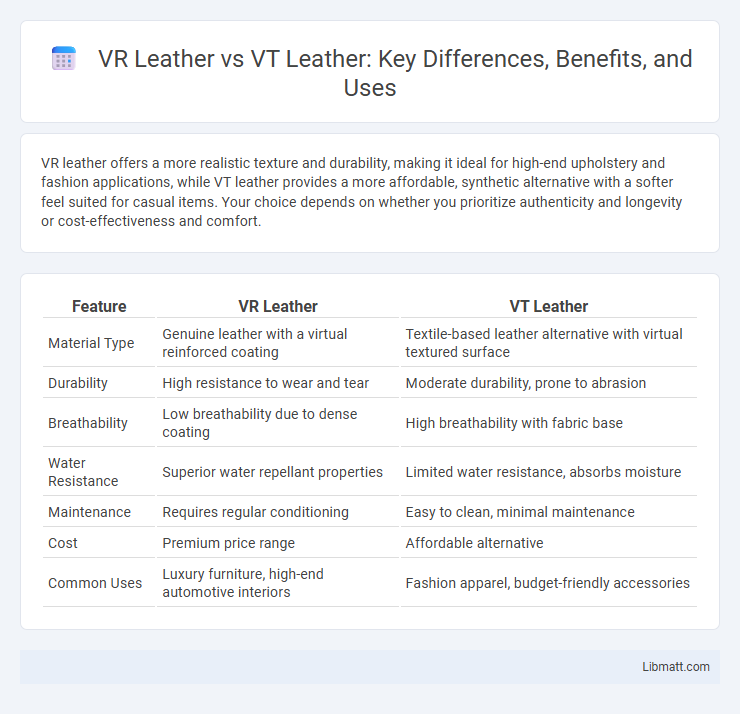VR leather offers a more realistic texture and durability, making it ideal for high-end upholstery and fashion applications, while VT leather provides a more affordable, synthetic alternative with a softer feel suited for casual items. Your choice depends on whether you prioritize authenticity and longevity or cost-effectiveness and comfort.
Table of Comparison
| Feature | VR Leather | VT Leather |
|---|---|---|
| Material Type | Genuine leather with a virtual reinforced coating | Textile-based leather alternative with virtual textured surface |
| Durability | High resistance to wear and tear | Moderate durability, prone to abrasion |
| Breathability | Low breathability due to dense coating | High breathability with fabric base |
| Water Resistance | Superior water repellant properties | Limited water resistance, absorbs moisture |
| Maintenance | Requires regular conditioning | Easy to clean, minimal maintenance |
| Cost | Premium price range | Affordable alternative |
| Common Uses | Luxury furniture, high-end automotive interiors | Fashion apparel, budget-friendly accessories |
Overview of VR Leather and VT Leather
VR leather, an innovative synthetic material, offers a durable, eco-friendly alternative to traditional leather, characterized by its high breathability and smooth texture. VT leather, another advanced synthetic option, is known for its enhanced flexibility and superior resistance to wear and tear, making it ideal for automotive and upholstery applications. Both VR and VT leather provide sustainable, cost-effective solutions with distinct physical properties tailored to different end-uses in fashion and manufacturing industries.
Definitions: What is VR Leather?
VR leather, or Virtual Reality leather, refers to synthetic leather materials designed to simulate the texture and appearance of genuine leather, often used in VR environments for realistic tactile experiences. VT leather, or Vinyl Textured leather, is a type of artificial leather made from vinyl, offering durability and water resistance while mimicking real leather's look. Your choice between VR leather and VT leather depends on the specific application requirements, such as comfort, durability, and realism.
Definitions: What is VT Leather?
VT leather is a type of artificial leather made by applying a polyurethane (PU) coating onto a fabric base, providing enhanced durability and water resistance compared to traditional materials. VR leather, by contrast, typically refers to leather with a vinyl resin finish, offering a different texture and flexibility. Understanding these distinctions helps you choose the right synthetic leather for upholstery, fashion, or automotive applications.
Manufacturing Processes of VR and VT Leather
VR leather is produced using a vacuum rotational molding process that enhances material density and durability by distributing heat and pressure evenly, resulting in superior surface texture and strength. VT leather, on the other hand, relies on vacuum thermoforming techniques where heated leather sheets are shaped over molds, allowing for precise contours but often with less uniform material consistency. Understanding these manufacturing differences helps you choose the leather type best suited for products requiring either enhanced structural integrity or detailed shaping.
Material Composition: VR vs VT Leather
VR leather typically consists of polyurethane (PU) applied over a fabric base, offering a synthetic, vegan-friendly alternative to natural hides. VT leather, or vegetable-tanned leather, is made from animal hides treated with tannins derived from plant materials, resulting in a more organic and biodegradable product. Your choice between VR and VT leather depends on preferences for durability, texture, environmental impact, and ethical considerations around animal use.
Durability and Longevity Comparison
VR leather offers superior durability due to its high-quality synthetic composition, making it resistant to wear, cracking, and fading over time. VT leather, while more affordable, tends to have a shorter lifespan as it may degrade faster when exposed to regular use and environmental factors. Choosing VR leather ensures your products maintain their aesthetic appeal and structural integrity for a longer period, providing better long-term value.
Texture and Feel: Sensory Differences
VR leather typically features a more uniform texture with a smooth, consistent grain pattern that emulates natural leather's softness but can feel slightly synthetic to the touch. VT leather offers a richer, more varied texture with subtle natural imperfections and a supple, warm feel, closely mimicking genuine leather's tactile qualities. Sensory differences are evident as VR leather tends to be less breathable and firmer, while VT leather provides enhanced flexibility and a more authentic sensory experience.
Environmental Impact and Sustainability
VR leather, often derived from polyvinyl chloride (PVC) or polyurethane (PU), poses significant environmental concerns due to the release of harmful chemicals during production and limited biodegradability, contributing to pollution and landfill waste. VT leather, typically made from vegetable-tanned processes using natural tannins from tree bark and plant extracts, offers greater biodegradability and lower toxic emissions, enhancing its sustainability profile. Choosing VT leather supports eco-friendly production practices and reduces long-term environmental impact compared to the synthetic nature of VR leather.
Use Cases: Best Applications for VR and VT Leather
VR leather, known for its durability and water resistance, is ideal for automotive interiors, upholstery, and high-traffic commercial furniture where longevity and easy maintenance are essential. VT leather, prized for its natural texture and breathability, works best in luxury goods, fashion accessories, and premium upholstery where aesthetic appeal and comfort are priorities. Your choice between VR and VT leather should align with the specific demands of your application, balancing durability against tactile experience.
Cost Comparison and Market Trends
VR leather generally costs 30-50% less than VT leather due to its synthetic polyurethane base, making it a budget-friendly option for upholstery and fashion. Market trends indicate rising demand for VR leather driven by sustainability concerns and improved durability, while VT leather maintains a premium status favored for luxury goods. The global VR leather market is projected to grow at a CAGR of 7.5% from 2024 to 2030, reflecting shifting consumer preferences.
VR leather vs VT leather Infographic

 libmatt.com
libmatt.com